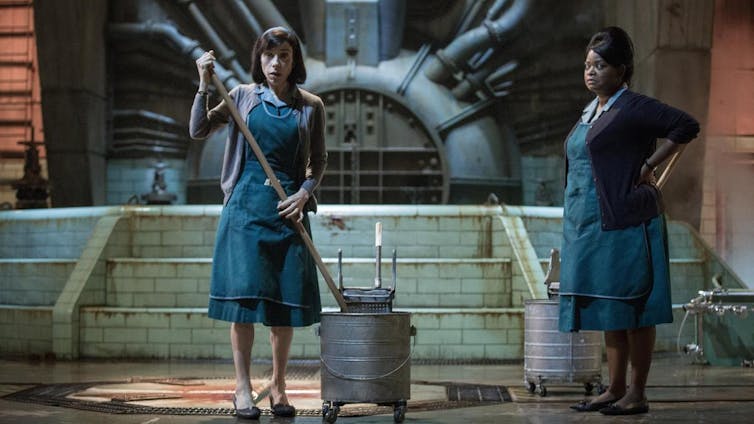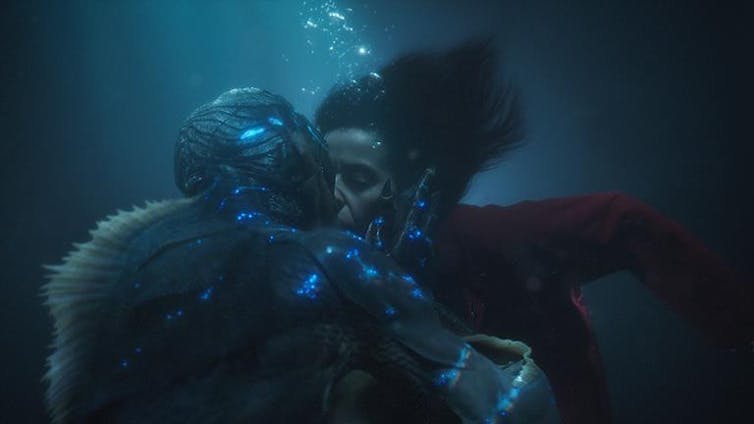The Cold War is in full swing in the film, and the dichotomy between the United States and Russia, between “good” and “evil,” is both referenced and undermined.
by John Richardson
( March 19, 2018, Boston, Sri Lanka Guardian ) Resistance to Donald Trump’s presidency has taken many forms, including legal challenges, resignations, media criticism, women’s marches, political rebukes and endless rounds of late night mockery. The Best Picture winner at the 90th Academy Awards provides another, less obvious example of resistance. The top film was The Shape of Water, an allegorical love story between a mute woman and a green sea monster.
I am a high school English teacher and an adjunct professor in the University of Ottawa’s Faculty of Education with a background in live theatre, critical pedagogy and youth culture. I teach Bachelor of Education students who may one day teach high school English classes.
Part of my course covers the importance of critical literacy, which I believe we can teach by asking teenagers to view film as more than just entertainment but as a vital source of insight on contemporary culture, issues and society.
Many of my classroom discussions focus on the ways in which this year’s top movies, not just Oscar nominees, offer clever responses to the racist, sexist and xenophobic policies and rhetoric that have accompanied Trump’s rise to the top.
Lady Bird argues that the lives of young women are worthy of exploration. Three Billboards Outside of Ebbing, Missouri offers a flamethrower portrayal of the corruption, racial conflict and violence at the heart of the American dream. Black Panther triumphantly demonstrates that Black actors and filmmakers can produce a Hollywood blockbuster and that African-American culture can yield an exciting, mythological story appealing to all audiences.
But it is The Shape of Water that offers the most detailed, poetic critique of Trump and the hollow promises of his “Make America Great Again” philosophy.
Lives of quiet oppression
Set in 1962 Baltimore, director Guillermo Del Toro’s film tells the story of Elisa, a young mute woman who works as a cleaner at a mysterious government facility that is home to a recently captured “Amphibian Man.” Zelda is her African-American co-worker and Giles, a gay graphic designer whose work and identity are “ahead of his time,” is her roommate.These are the Americans who live lives of quiet oppression in the past-tense America that shimmers, mythical and revered, at the heart of the Trump campaign promise. The film both upholds and undermines the old mythologies that can provide comfort and reassurance to people whose lives have been disrupted by global trade, population movements and the emergence of AI in the workplace.

(Kerry Hayes/Fox Searchlight Pictures)
The Cold War is in full swing in the film, and the dichotomy between the United States and Russia, between “good” and “evil,” is both referenced and undermined.
Americans and Russians are in conflict, but it’s a Russian agent who acts ethically. There is a traditional Main Street dessert shop, but the affable server turns out to be a vile racist and homophobe who adopts a southern accent for marketing purposes and is actually from Ottawa.
The pies look appealing, but they are mass-produced and the store is part of a new phenomena, the franchise. The film is poised at the moment when authenticity is being lost to illusion.
A Trump proxy
Opposing the quiet, marginalized Americans is Strickland, a shadowy government worker upon whose character the filmmakers apply hateful qualities like layers of slime. It becomes evident that Strickland is designed as a bridge to Trump’s present-day political toxicity when a smooth-talking car salesman tells him: “You are the man of the future.”A further connection to Trump is made when Strickland announces: “The future is bright. You gotta trust in that. This is America.” Here the film has fun with its ironic presentation of the past. As audience members in 2018 watching a film set in a period of time more than half a century ago, we may question whether the future has indeed turned out to be “bright.”
Reading news stories about the Robert Mueller investigation into the Trump campaign’s alleged involvement with Russia, we may feel profoundly uneasy about the relationship between trust and leadership.
Witnessing the assault on otherness and a turn to American nativism, we may question what it now means to be American, and where a nation that was once so welcoming to immigrants has gone.

(Kerry Hayes/Fox Searchlight Pictures)
But then the film also picks up on the way in which truth in the Trump era has been attacked, questioned and undermined. “Bonanza is not violent. It’s real life. The way it was,” Strickland tells his son about the popular Western TV show of the time. A TV show is said to be “true” much in the same way that Trump draws on cable news personalities as experts fit to serve in the White House.
Like Trump, Strickland boasts about his power to sexually assault women when he harasses silent Elisa with the line: “Bet I can make you squawk a little.” He has sex with his wife in a mechanical manner that diminishes and belittles her. His casual vulgarity oozes male privilege. His repellent masculinity crowds out a woman’s agency.
Strickland calls the beautiful South American Amphibian Man an “affront” and takes pleasure in torturing him with his sizzling cattle prod.
“How did they get in?” he asks of the Russian agents who infiltrated his facility, the question echoing the current political discourse around “illegals” and “shithole countries” as well as the president’s restrictive immigration policies.
A rebuke to ignorance
When the mute woman, the Black woman and the gay man act together to free the beautiful “undesirable” from his prison, the film suggests that the creativity and humanism of outsiders can prevail against cruelty and corruption.Cowardly, vile and literally rotting from having lost fingers earlier in the story, Strickland dies by the same violence he promulgated. He is the real monster. Elisa and Amphibian Man fall in love and slip away to a watery paradise. Breathing underwater, she opens her eyes and looks at him. She is alive.
John Richardson, Adjunct Professor, Faculty of Education, University of Ottawa
This article was originally published on The Conversation. Read the original article.











Post a Comment